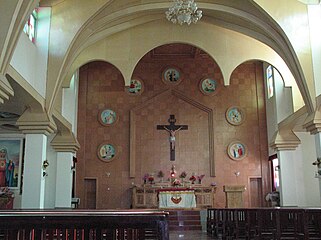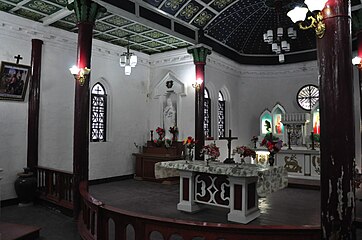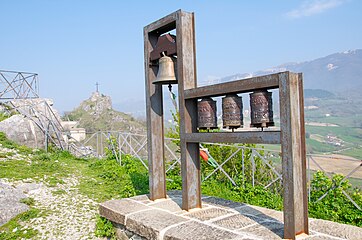Catholic Church in Tibet
The Catholic Church is a minority religious organization in Tibet, where Tibetan Buddhism is the predominate faith. Its origin dates from the 17th century, when António de Andrade, a Portuguese Jesuit through the Jesuit Mission to Tibet, introduced Catholicism into the Kingdom of Guge in western Tibet.[1]
The Catholic Church of Lhasa was the first Catholic church built in Tibet, but was destroyed in 1745. Today, Our Lady of the Sacred Heart Church at Yerkalo in Chamdo is the only Catholic church in the Tibet Autonomous Region (Tibet proper), in addition to chapels and churches scattered throughout the incorporated Tibetan territories in Sichuan (Szechwan) and Yunnan.
History[edit]
17th and 18th centuries[edit]
The first Catholic missionaries to arrive in Tibet, António de Andrade and Manuel Marques, reached the Kingdom of Guge (western Tibet) in 1624. They were welcomed by the royal family and later allowed to build a church.[2][3] These two Portuguese Goa-based Jesuits had the benefit of the syncretic policy of Akbar (1542–1605), maintained by his son Jahangir (1569–1627), which allowed them to develop freely in an environment under Muslim authority.[4]
In 1627, there were about a hundred converts in the kingdom. Catholicism also spread to Rudok, Ladakh (Indian Tibet) and Ü-Tsang (Central Tibet), and was welcomed by the ruler of the kingdom of Ü-Tsang, where in 1626 Andrade and his companions established a Jesuit outpost at Shigatse.[5] In 1635, a six-missionary expedition to Tsaparang, capital of Guge, was led by Nuño Coresma, a Spanish Jesuit.[6]
In 1661, an Austrian Jesuit Johann Grueber crossed Tibet from Sining to Lhasa, where he spent a month, before heading to Nepal.[7] The Italian Jesuit Ippolito Desideri was the first known European to successfully study and understand the Tibetan language and culture during his six-year stay in Tibet (1715–1721).[8] The 18th century also saw the arrival of several Capuchin missionaries supported by donations from New Spain,[9] who built the no longer existing Catholic Church of Lhasa in 1726.[10] Catholicism was used by some Tibetan monarchs, their courts and the lamas of the Karmapa school to counterbalance the influence of the Gelug school since the 17th century until in 1745, when all missionaries were expelled at the insistence of the lamas.[11] Tibet was closed to foreigners, although this district came under the authority of the Mission sui iuris of Hindustan in 1792, no more missionaries arrived until 1844.[12]
19th century[edit]
In 1844, Évariste Régis Huc, a French Lazarist, prepared his trip to Tibet at the suggestion of the Apostolic Vicar of Mongolia (Joseph-Martial Mouly). In September 1844 he arrived in Dolon Nor and made preparations for his journey. Shortly after, he was accompanied by a young fellow Lazarist, Joseph Gabet.[13] In January 1845 they reached Tang-kiul, a frontier trading post between the Chinese, Mongolian, and Tibetan cultural spheres. Instead of undertaking an independent four-month trip to Lhasa, they waited eight months for a Tibetan embassy to return from Peking. Meanwhile, under the guidance of an intelligent teacher, they studied the Tibetan language and Buddhist literature. During the three months of their stay they resided in Kumbum Monastery, which was said to have capacity for 4,000 people.[14]
On March 27, 1846, the Apostolic Vicariate of Lhasa (now Diocese of Kangding, or Dartsedo) was erected with the brief Ex debito from Pope Gregory XVI, obtaining territory from the Apostolic Vicariate of Szechwan and the Apostolic Vicariate of Tibet-Hindustan. Evangelization was entrusted to the Paris Foreign Missions Society (MEP).[15] In 1847, Charles-René Renou set out disguised as a merchant for Dartsedo and then continued his journey towards Chamdo. He was recognized and arrested in 1848 and escorted back to Guangzhou, southern China.[16] At the same time, Nicolas Krick and Augustin Bourry approached Tibet from the south, from Assam in northeastern India.[17] In 1856, Pope Pius IX commissioned Eugène-Jean-Claude-Joseph Desflèches, Apostolic Vicar of Eastern Szechwan, to choose a vicar for the Mission of Lhasa. The next year, Léon Thomine Desmazures was installed as the first Apostolic Vicar of Lhasa.[18] In 1865, Félix Biet and Auguste Desgodins established the parish of Yerkalo in Chamdo. The parish church was blessed on August 15, 1873,[19] and dedicated to Our Lady of the Sacred Heart.[20]
In Yunnanese Tibet, following the establishment of the parish of Tsekou (later transferred to Cizhong; Sacred Heart Church, Cizhong) in 1867 by Jules Dubernard,[21] Xiaoweixi (Sacred Heart Church, 1880), Dimaluo (Bahang Catholic Church, 1899) and Zhongding (Sacred Heart Church, 1908) were successively occupied by French missionaries. Although the last two are located in the Nu and Lisu lands, this district was still part of the Mission of Tibet and later of the Diocese of Kangding.[22]
20th century[edit]
After the British expedition to Tibet in 1904, Auguste Desgodins was appointed "parish priest of Lhasa" by Pierre-Philippe Giraudeau, Apostolic Vicar of Tibet, but he never traveled to Lhasa.[23] In 1905, four French missionaries were killed in the Bathang uprising, including Jean-André Soulié. He was captured, tortured and shot by lamas close to Yaregong.[24] Nine years later (1914), Jean-Théodore Monbeig, another French missionary working in the Sichuan-Tibetan border region, was killed by lamas near Lithang, not long after helping revive the Christian community at Bathang.[25][26]
After the fall of the Manchu empire in 1911, attempted invasions of Tibet in 1917 and in 1930 did not help the establishment of the Paris Foreign Missions. Some of these missionaries had difficulty adapting to the climate, so after 1930 a dozen canons of the Chanoines réguliers du Grand-Saint-Bernard were sent to Yunnanese Tibet at the invitation of Jean de Guébriant, Apostolic Vicar of Kienchang. These were young missionaries seasoned in the Swiss Alps, who also had a project of building a hospice in 1933 in the Latsa pass, between the valleys of the Mekong and Salween rivers.[27] In 1945, Valais-born Maurice Tornay was appointed parish priest of Our Lady of the Sacred Heart Church at Yerkalo, after completing his theological and local language studies in Weisi. His conflicts with the local lamas led him to travel to Lhasa to appeal before the 14th Dalai Lama in 1949, but was assassinated by four armed lamas at Cho La, Sichuan. He was beatified on May 16, 1993, by Pope John Paul II.[28]
In 1930, Pascual Nadal Oltra, a Pego-born Spanish Franciscan friar and artist, arrived in Mosimien (a.k.a. Boxab by its Tibetan name), a small town located in Sichuanese Tibet. With the support of the Bishop of Tatsienlu (Pierre-Philippe Giraudeau) and his coadjutor Pierre Valentin, Oltra, the Father Guardian Plácido Albiero, a Canadian friar Bernabé Lafond and an Italian José Andreatta formed the founding community of a leper colony established near St. Anne's Church,[29] known as St. Joseph's Home.[30] In May 1935, a communist army column led by Mao Zedong (Mao Tse Tung) was fleeing Chiang Kai-shek's regular army to northwest China through the Mosimien area, part of a military retreat later known as Long March. According to the Valencian Franciscan friar José Miguel Barrachina Lapiedra, author of the book Fray Pascual Nadal y Oltra: Apóstol de los leprosos, mártir de China, and a report published in Malaya Catholic Leader, the official newspaper of the Roman Catholic Archdiocese of Singapore: "The communist soldiers entered the leper colony, they looted the residence and arrested the friars and sisters. Many of the lepers tried to defend the missionaries, but they were shot by the soldiers. The Franciscans were then brought before Mao Tse Tung, who interrogated them, imprisoned two of them, Pascual Nadal Oltra and an Italian friar Epifanio Pegoraro, and released the rest. There were more than 30,000 Reds in the band, including a large number of women. Before their departure, the soldiers ransacked the village, carrying away everything movable and edible, left the people of the district without means of subsistence. Days later, on 4 December 1935, the army reached Leang Ho Kow, Tsanlha, where the two Franciscans were beheaded with a sword."[31][32][33] Nevertheless, the missionaries managed to recover and welcome back the sick after the devastation, who in 1937 were 148 people.[34]
Current situation[edit]
After the communist takeover of China in 1949, and the subsequent Annexation of Tibet by the People's Republic of China in 1951, Catholicism in China, like all religions, has since been permitted to operate only under the supervision of the State Administration for Religious Affairs. All legal worship has to be conducted in government-approved churches belonging to the Catholic Patriotic Association, which does not accept papal primacy.[35] Some missionaries were arrested and sent to "thought reform centers" in which they underwent disturbing re-education process in a vindictive prison setting.[36]
In 1952, following the expulsion of Pierre Valentin, the then Bishop of Kangding, the communist regime put an end to the missionary presence in Tibet, since then the Diocese of Kangding has been left without a bishop.[37] According to a report by the Catholic International Press Agency, in 1989, a group of Catholics were found living in Lhasa, the capital of Tibet. A Church collaborator in Chongqing told the agency that there were approximately 10,000 Tibetan Catholics in the Diocese of Kangding. He further stated that, at the time, no one knew exactly the situation of the Catholic Church in that country.[38]
In 1989, while an administrator of the Diocese of Qinzhou, John Baptist Wang Ruohan was consecrated "underground bishop" of Kangding by Paul Li Zhenrong, Bishop of Xianxian.[39] In 2011, John Baptist was arrested by Chinese security forces, along with his brothers, Bishop Casimir Wang Mi-lu and Father John Wang Ruowang, as well as a group of lay faithful, who do not belong to the government-authorized Catholic Patriotic Association.[40]
On September 3, 2011, an attack occurred against a nun and a priest in Mosimien. Sister Xie Yuming and Father Huang Yusong were attacked by a dozen unknown assailants after attempting to recover two former properties of the Diocese of Kangding. The nun was brutally beaten while the priest suffered minor injuries. The properties, a former Latin school and a boys' school, are among several properties that were confiscated by authorities in the 1950s but were due to be returned to the diocese. At that time, the Latin school was demolished by the government and the land occupied by a private company; the boys' school was used as housing for officials of the Mosimien regional government. The attack sparked anger among many parishioners who gathered to protest in front of St. Anne's Church.[41]
According to Baptiste Langlois-Meurinne, a member of the Raiders Scouts, in 2014, while helping with the development of the Tibetan Catholic populations of the Mekong and Salween valleys through the Sentiers du ciel association, he met a Vatican priest —that is, not affiliated to the official Chinese Patriotic Church— who organized a clandestine camp for Bareng children where he taught them Tibetan, English and catechism.[42]
Gallery[edit]
Except for the Catholic Church of Lhasa, all churches belong to the Roman Catholic Diocese of Kangding (former Apostolic Vicariate of Lhasa/Tibet/Tatsienlu).
Bahang Catholic Church (Dimaluo; part of Tibetan Mission)
Former Sacred Heart Church, Zhongding (Koksang; part of Tibetan Mission)
A surviving bell of the Catholic Church of Lhasa
See also[edit]
References[edit]
- ↑ Russell-Wood, A. J. R. (July 31, 1998). The Portuguese Empire, 1415–1808: A World on the Move. Baltimore: Johns Hopkins University Press. p. 90. ISBN 9780801859557.
- ↑ Sanderg, Graham (1973). The Exploration of Tibet: History and Particulars. Delhi: Cosmo Publications. pp. 23–26.
- ↑ Holdich, Thomas (1906). Tibet, the Mysterious. London: Alston Rivers. p. 70.
- ↑ Didier, Hugues (2002). Les Portugais au Tibet : les premières relations jésuites (1624–1635) (in français). Paris: Éditions Chandeigne. ISBN 9782906462311.
- ↑ Wu, Kunming (1992). 早期传教士进藏活动史 [History of the activities of the first missionaries in Tibet] (in 中文(简体)). Beijing: China Tibetology Publishing House. p. 163. ISBN 7-80057-072-X.
- ↑ Wessels, Cornelius (1924). Early Jesuit Travellers in Central Asia, 1603–1721. Delhi: Low Price Publications. p. 82.
- ↑ Markham, Clements R., ed. (1989) [1881]. Narratives of the Mission of George Bogle to Tibet, and of the Journey of Thomas Manning to Lhasa. New Delhi: Cosmo Publications. pp. 295–302.
- ↑ Seitz, Jonathan Andrew (2011). "Jesuit on the Roof of the World: Ippolito Desideri's Mission to Tibet". Buddhist-Christian Studies. 31. Retrieved September 22, 2023.
- ↑ Lorenzen, David N. (2013). "La Misión del Tíbet en Nueva España: las limosnas y el cobro del legado de Spinola". Historia Mexicana (in español). 63 (2): 591–643. Retrieved September 23, 2023.
- ↑ Grasdorff, Gilles van (2008). À la découverte de l'Asie avec les Missions étrangères (in français). Paris: Éditions Omnibus. p. 666. ISBN 978-2-258-07693-8.
- ↑ Lin, Hsiao-ting (2004). "When Christianity and Lamaism Met: The Changing Fortunes of Early Western Missionaries in Tibet". Pacific Rim Report (36). Archived from the original on June 26, 2010. Retrieved September 22, 2023.
- ↑ Hambye, E. R. (ed.). "Tibet, The Catholic Church In". encyclopedia.com. Retrieved September 23, 2023.
- ↑ Template:Cite CE1913
- ↑ . Encyclopædia Britannica. Vol. 13 (11th ed.). 1911. pp. 846–847.
- ↑ Launay, Adrien (1903). Histoire de la Mission du Thibet, tome premier (in français). Paris: Desclée, de Brouwer et cie. p. 66.
- ↑ Dubernard, Étienne-Jules (1990). Tibet " Mission Impossible " : Lettres du Père Étienne-Jules Dubernard (in français). Paris: Le Sarment-Fayard. ISBN 2866790588.
- ↑ Hattaway, Paul (2007). "1854 - Nicolas Krick & Augustin Bourry". asiaharvest.org. Retrieved September 22, 2023.
- ↑ Goré, Francis (1992). Trente ans aux portes du Thibet interdit (in français). Paris: Éditions Kimé. ISBN 2-908212-25-0.
- ↑ Gratuze, Gaston (1968). "Père Desgodins Auguste". mission-thibet.org (in français). Retrieved September 22, 2023.
- ↑ Launay, Adrien (1903). Histoire de la Mission du Thibet, tome deuxième (in français). Paris: Desclée, de Brouwer et cie. pp. 74–75.
- ↑ "Jules DUBERNARD". irfa.paris (in français). Retrieved September 22, 2023.
- ↑ Savioz, Alphonse (2022). "Tibetan Catholics" (PDF). hsstudyc.org.hk. Retrieved September 22, 2023.
- ↑ Deshayes, Laurent; Lenoir, Frédéric (2002). L'épopée des Tibétains : entre mythe et réalité (in français). Paris: Éditions Fayard. p. 107. ISBN 9782213610283.
- ↑ Launay, Adrien (1905). "Un Missionnaire Massacré au Thibet : M. Soulié". archives.mepasie.org (in français). Archived from the original on November 22, 2015. Retrieved September 22, 2023.
- ↑ "Jean-Théodore MONBEIG". irfa.paris (in français). Retrieved September 22, 2023.
- ↑ "Monbeig, Jean-Théodore (1875-1914)". plants.jstor.org. Retrieved September 22, 2023.
- ↑ Bonet, André (2006). Les chrétiens oubliés du Tibet (in français). Paris: Presses de la Renaissance. ISBN 2856168914.
- ↑ "Maurice Tornay". causesanti.va (in italiano). Retrieved September 22, 2023.
- ↑ Barrachina Lapiedra, José M. (1990). Fray Pascual Nadal y Oltra: Apóstol de los leprosos, mártir de China (in español). Valencia: Unión Misional Franciscana. p. 59. ISBN 84-404-8209-4.
- ↑ "Leprosy Institutions in China" (PDF). International Journal of Leprosy. 17: 469. 1949. Retrieved September 22, 2023.
- ↑ Garcia, Sara (November 29, 2006). "Investigació a fons de la mort de Fra Pascual Nadal Oltra". radiopego.com (in Valencian). Retrieved September 22, 2023.
- ↑ "Investigan la muerte en 1935 de un fraile de Pego en China". lasprovincias.es (in español). 29 November 2006. Retrieved September 22, 2023.
- ↑ "Abducted Franciscans Still Missing: Leper Asylum Near Tibetan Border Invaded by Reds". Malaya Catholic Leader. Vol. 1, no. 35. Singapore. 31 August 1935. p. 7. Retrieved September 22, 2023.
- ↑ Moulier, Pascale (2020). "Une missionnaire aurillacoise au Tibet". diocese15.fr (in français). Retrieved September 22, 2022.
- ↑ Moody, Peter R. (2013). "The Catholic Church in China Today: The Limitations of Autonomy and Enculturation". Journal of Church and State. 55 (3): 403–431. doi:10.1093/jcs/css049. JSTOR 23922765. Retrieved September 22, 2022.
- ↑ Lifton, Robert J. (1957). "Chinese Communist 'Thought Reform': Confession and Re-Education of Western Civilians". Bulletin of the New York Academy of Medicine. 33 (9): 626–644. PMC 1806208. PMID 19312633.
- ↑ "Chronologie historique détaillée du Tibet". tibet-info.net (in français). April 27, 2008. Retrieved September 22, 2023.
Février 1952 : Expulsion par la troupe communiste chinoise du Père Valentin du Tibet oriental désormais sous contrôle de la Chine. Fin de 106 ans d'efforts de christianisation du Tibet.
- ↑ "Chine : toujours des catholiques au Tibet". cath.ch (in français). September 8, 1989. Retrieved September 22, 2023.
- ↑ Brender, Andreas (2012). "Bishops in China, W: Wang Ruohan, John Baptist". bishops-in-china.com. Retrieved September 22, 2023.
- ↑ Wang, Zhicheng (August 24, 2011). "Tianshui: police arrest dozens of underground priests and lay faithful". asianews.it. Retrieved September 22, 2023.
- ↑ "Nun, priest beaten by mob". ucanews.com. 6 September 2011. Retrieved September 22, 2023.
- ↑ Langlois-Meurinne, Baptiste (October 2014). "Un chevriot sur le toit du monde" (PDF). mairie-chevrieres.fr (in français). p. 5. Retrieved September 22, 2023.
External links[edit]
- The St Bernard Mission to Tibet (a 21-minute documentary) at YouTube
- China's tiny Catholic Tibetan community's uneasy truce with the Communist Party (The Telegraph report) at YouTube
Template:Christianity in Tibet Template:Christianity in Sichuan









![Sacred Heart Church, Cizhong [fr] (Yunnanese Tibet)](https://upload.wikimedia.org/wikipedia/commons/thumb/8/8a/Catholic_Church_Cizhong_Yunnan_China.jpg/169px-Catholic_Church_Cizhong_Yunnan_China.jpg)

![St. Anne's Church, Mosimien [es] (Sichuanese Tibet)](https://upload.wikimedia.org/wikipedia/commons/thumb/8/87/St._Anne%27s_Church%2C_Mosimien.png/212px-St._Anne%27s_Church%2C_Mosimien.png)

![Bahang Catholic Church [fr] (Dimaluo; part of Tibetan Mission)](https://upload.wikimedia.org/wikipedia/commons/thumb/8/8f/%C3%89glise_de_Bahang_dans_les_ann%C3%A9es_1920.png/190px-%C3%89glise_de_Bahang_dans_les_ann%C3%A9es_1920.png)


